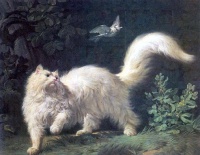Bird
From The Art and Popular Culture Encyclopedia
|
"Fifty million years before the first bird would appear the insects had accomplished flight."--The Hellstrom Chronicle (1971) Birds of Venezuela (1973) by Jean-Claude Roché |
|
Related e |
|
Featured: |
Birds (class Aves or clade Avialae) are feathered, winged, bipedal, endothermic (warm-blooded), egg-laying, vertebrate animals. With around 10,000 living species, they are the most speciose class of tetrapod vertebrates. All present species belong to the subclass Neornithes, and inhabit ecosystems across the globe, from the Arctic to the Antarctic. Extant birds range in size from the 5 cm Bee Hummingbird to the 2.75 m Ostrich. The fossil record indicates that birds emerged within theropod dinosaurs during the Jurassic period, around 150 million years ago. Birds are the only members of the clade originating with the earliest dinosaurs to have survived the Cretaceous–Paleogene extinction event.
Religion, folklore and culture
Birds play prominent and diverse roles in folklore, religion, and popular culture. In religion, birds may serve as either messengers or priests and leaders for a deity, such as in the Cult of Makemake, in which the Tangata manu of Easter Island served as chiefs; or as the rooster(cock) serves as a tangible vessel of Christ as in the gospel of –Matthew, Mark and Luke in the New Testament with Christ speaking through the cock; or as attendants, as in the case of Hugin and Munin, two Common Ravens who whispered news into the ears of the Norse god Odin. In several civilizations of ancient Italy, particularly Etruscan and Roman religion, priests were involved in augury, or interpreting the words of birds while the "auspex" (from which the word "auspicious" is derived) watched their activities to foretell events. They may also serve as religious symbols, as when Jonah (Hebrew: יוֹנָה, dove) embodied the fright, passivity, mourning, and beauty traditionally associated with doves. Birds have themselves been deified, as in the case of the Common Peacock, which is perceived as Mother Earth by the Dravidians of India. Some birds have also been perceived as monsters, including the mythological Roc and the Māori's legendary Pouākai, a giant bird capable of snatching humans.
Birds have been featured in culture and art since prehistoric times, when they were represented in early cave paintings. Birds were later used in religious or symbolic art and design, such as the magnificent Peacock Throne of the Mughal and Persian emperors. With the advent of scientific interest in birds, many paintings of birds were commissioned for books. Among the most famous of these bird artists was John James Audubon, whose paintings of North American birds were a great commercial success in Europe and who later lent his name to the National Audubon Society. Birds are also important figures in poetry; for example, Homer incorporated Nightingales into his Odyssey, and Catullus used a sparrow as an erotic symbol in his Catullus 2. The relationship between an albatross and a sailor is the central theme of Samuel Taylor Coleridge's The Rime of the Ancient Mariner, which led to the use of the term as a metaphor for a 'burden'. Other English metaphors derive from birds; vulture funds and vulture investors, for instance, take their name from the scavenging vulture.
Perceptions of various bird species often vary across cultures. Owls are associated with bad luck, witchcraft, and death in parts of Africa, but are regarded as wise across much of Europe. Hoopoes were considered sacred in Ancient Egypt and symbols of virtue in Persia, but were thought of as thieves across much of Europe and harbingers of war in Scandinavia.
See also




